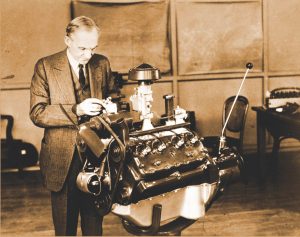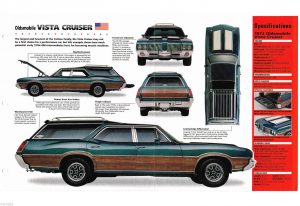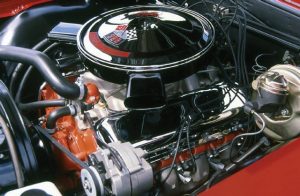Henry Ford gets the credit for putting America on wheels via the Model T – which was not only the first mass-produced car but also the first affordable car, which is what made its mass production possible.
Ford’s other achievement, however, wasn’t a car. It was an engine. The first mass-produced and – like the T – affordable V8 engine. Chuck Berry sang about it in Maybellene:
I was motorvatin’ over the hill
I saw Maybellene in a Coupe de Ville
A Cadillac a-rollin’ on the open road
Nothing outrun my V8 Ford
The Ford flathead V8 came out in 1932 and – just like the T – it changed everything. It was light and inexpensive and easy to manufacture. So it could be sold inexpensively – and in quantity.
Previously – just as cars had once been for the affluent-only – V8 engines were ornate, complex and expensive. They were indulgences of the affluent – not unlike an electric car today.
The flathead Ford V8 upended that. For the next 60-plus years, the average American could afford to drive not just a car, but a car with a V8.
A big car.
These, too, became commonplace – and uniquely American. In no other country could you see fleets of big cars being driven by ordinary people. It was extraordinary.
V8s made that feasible.
And the V8s grew to be even bigger.
By the early ‘70s, it was common for sedans (and station wagons) to have engines in the seven liter range. These were middle-of-the-road family sedans and wagons. Not high-end models.
Everyone coulda had a V8 – or just about.
These were six passenger full-size (and rear-wheel-drive) cars and wagons – the wagons often being nine passenger-capable. The roads abounded with them. They were the analogs – from the ’50s through the ’60s and into the ’70s – of a Camry or Accord.
Then along came Uncle – and once again, everything changed.
Most people now drive cars like Camrys or Accord – if they are lucky. Mid-sized cars with four and – maybe, occasionally – a six cylinder engine.
Almost always front-wheel-drive.
They are very nice cars, but diminished in a tangible way – at least for those who can still recall a different time. 
Today, V8s are – mostly – for the rich only. Or at least, the very comfortably affluent. There is only one new sedan priced under $40,000 that comes with a V8 – the 2017 Dodge Charger R/T, which stickers for $34,895 to start.
It is a great car – particularly because of its stout 5.7 liter Hemi V8. But whip out your inflation calculator. That $35,000 (I rounded) is equivalent to about $5,500 in 1970 money (see here). And in 1970, you could buy a full-size (the Charger is mid-size) Chevy Impala (here) with a 7.4 liter 454 V8 for just over $3,200 – which is the equivalent in today’s dollars of about $20,500.
This is just a couple of thousand dollars less than the current price of a brand-new four-cylinder (and FWD) Camry ($23,070).
Large, rear-drive cars are all-but-extinct. Unless you can afford a Benz or a BMW or Lexus or Infiniti or Porsche. These brands still sell rear-drive cars and cars with V8s. But – notice – they are all luxury brand cars. They sell small numbers – at high cost.
It is because Uncle.
He didn’t outlaw big cars – or V8s. Not exactly. He just made them expensive so that – once again – they are for the rich only only.
Cleverly, he did this indirectly – so he would not get the blame – by fining the car companies for making them. These fines – “gas guzzler” taxes – are folded into the price of not just the large/V8-powered cars (the ones that remain) but also drive up the cost of other cars – making it twice as tough to make the big ones with big engines.
This is why they are rare – and becoming more so- as they shuffle down the road to extinction.
The V8 Charger probably will soon join their ranks, incidentally. Unless Trump remembers why he was elected, stops bombing foreigners and instead rescinds the latest federal fuel economy fatwa – the one decreeing that all new cars must average at least 54.5 MPG by model year 2025 (seven years away, not that far in the future) it will no longer be possible for FiatChrysler to sell cars like the Charger – and its siblings, the Challenger coupe and the 300 sedan.
The only way they’ll get 54.5 MPG is by running a chain from underneath the radiator support to the bumper of a couple of Teslas serving as electric Clydesdales. They won’t get far, but they won’t burn much fuel.
The other option is for FiatChrysler to just fold the “gas guzzler” taxes into the price of the cars. This is what high-end brands like BMW and Mercedes do. But then, Dodge and Chrysler are not high-end brands. It is doubtful many people will pay $40,000-plus for a Dodge – and even if they wanted to, how many can afford to?
Henry Ford is often vilified but the man not only made mechanized personal transportation possible for the average man – he made it possible for the average man to live large.
Uncle’s agenda is rather different.
If you like what you’ve found here, please consider supporting EPautos.
We depend on you to keep the wheels turning!
Our donate button is here.
If you prefer not to use PayPal, our mailing address is:
EPautos
721 Hummingbird Lane SE
Copper Hill, VA 24079
PS: EPautos stickers are free to those who send in $20 or more to support the site. 











Is it so shocking that 8-cylinder cars are harder to find because 6-cylinders engines have the power of the older 8-cylinder engines?
Hi Anonymous,
THat’s true, about modern sixes having the power of older eights. But it’s not apples-apples. V8s just sound and feel better (usually).
Example: The current Camaro’s 3.6 liter V6 makes about as much (and possibly more) horsepower as the 7.4 liter 455 in my mid-1970s Trans-Am.
But the 455 has charms the 3.6 V6 hasn’t got and never could have – no matter how much horsepower it makes.
But the fact is that large engines are being extincted by the government, not because small engines have become stronger. Small engines have become stronger (usually, via turbos) to try to make up for the absence of the bigger engines.
I agree Eric. No modern engine sounds as nice as a cammed V-8 with headers. I have never even heard a cammed V-6 or straight 4.
Sound is a pretty subjective thing though I tend to agree.
https://www.youtube.com/watch?v=Xhwedudyuc4&feature=player_embedded
600+ whp 3800 V6, sounds very healthy to me.
One of the the reasons modern engines are ‘stronger’ (small or large) is because cylinder head design has vastly improved. New aftermarket heads (or correctly ported stockers in certain instances) will really wake up the old school stuff…
Plenty of 7.4’s still around forty years later. Try finding ONE 3.6 40 years from now!
Amen, Nunzio…
Every time I fire up the 455, I remember…
For me, it’s like the difference between a battleship and a modern missile frigate. Which is the more awesome sight? Or an old steam locomotive from the ’40s vs. a modern electric blecchhhhhh…
Eric, I don’t care how many horsepower* these modern li’l 4 and 6-bangers put out- they’re sissy-engines! They make that pathetic little ‘whizzzzz-whizzz!” sound when you rev ’em (That’s the sound of Uncle pissing all over us)- It’s like saying you have a “dog” guarding the junkyard, , but instead of hearing the rrrrRRROOFFFFf! of a Rottweiler, you hear the li’l “yap-yap-yap” of a Chihuahua!
[*= And I do believe the way they rate horsepower these days has been changed, and is now greatly exaggerated. I know it sure is for lawnmowers, as my 12HP 1970 Cub Cadet rider could literally run circles around my ’06 18HP Crapsman of the same deck size; and cut grass with ease that would choke the Crapsman]
Hey, Ya know, Eric? I like my V-10 -but knowing that it’s so politically-incorrect, and such an anomaly these days, makes me love it all the more!
I’m surprised there’s not some kind of aftermarket retro-fitting following turning up for these things- to put ’em in other vehicles. Then again….how many of these modern shoeboxes would they fit in? (Not that we can just swap engines anymore, anyway, if we can make ’em fit. Of course, with all the electronics and all, that’s pretty much a thing of the past….)
just found this old post, and can’t resist this one:
Recently I came across a clean, dead stock LOOKING Mazda Miata, BRG, slightly lowered, comfy-fat road tyres, but as it oh so gently accellerated through the roundabout I caught a whiff of its SOUND…. NOT the stock 2.X four… I guessed a smallblock Ford 60* V8. MAYBE 289. Exhaust was somewhat throaty but not obnoxiously so…. but then, VERY gentle throtttle on pullout. Traffic WAS heavy. Happened across the chap a ways up the road, stopped on the side waiting for someone. I was on my road bike,his window was open, so I hollered across the road (2 lane little traffic) hey tht one’s not quite stock , is it? He looked at me with a silly kid’s grin on his mug (looked to be mid-late 60’s) and said “noooooo, not quite”. OK, I asked, what IS under that bonet? He said it was indeed a V8. Hokay, what, maybe 289? He laughed and said, noooooo, not quite. Hokay, WHAT? I about fell off the bike when he told me it was a six point something litre L series Chev engine. WHAAAATTTTT???!!??? He got out, slipped the pins, and opened the bonnet. there it was.. full electronic injection, custom tuned/grouped headers, neatly tucked just inside the trunnions of the front suspension….. he said it produced a bit above 600 hp, had a six speed manual behind it. Engine dropped deeper into the frame, shifted about 3.5 inches back, resulting in 50/50 balance…. says it handles better than the stock Miata did before.
Not sure how final drive ratio was set up, whether for top speed or off the line acceleration, but he seemed to be the fast twisty road type, so I’m guessing a good compromise was reached. He’d had it to 150 plus, and was nowhere near top. Hm……….. he DID admit it would be his last project car….. thus he’d gone all out. VERY tasty ride. Good job we live in the county where all the state lawmakers have their residence…. the entire county is smog exempt. he’d never get that thing past the ecofreakoes as it does NOT have the “correct engine block”….. sigh.
Dang, Tio! What you just described sounds like the last remnants of automotive freedom (Or any freedom). The dying embers of vehicles that could still be customized; unique; and what their owners want them to be- limited only by budget and imagination.
It’s like the waning days of the old West….the sun is setting…and only a few old cowboys are left; and all that remains are just sissified pretty-boy queer actors….
Yeah, but this guy could not OWN and DRIVE that car if he lived in most any of our neighbouring counties. Swelf-centred legislators have carved out a comfort hole for themselves, and WE who happen to also live here get to occupy that hole as well. I don’t mind… having to surrrender your daily driver once a year for some gummit eedjits to “examine” is beyond insulting.. particularly since they have the “uthowriteh” to inform you that you can not continue operating that car until you spend $XXX.xx on “repairs” they deem necessary, when it runs just fine but happens to have a small exhaust leak, or maybe you don’t know how to reset the “check engine” light (I did, and its still there….. so what?) thus they refuse to deign you may drive that rig tomorrow.
I think perhaps the ultimate custom job I ever knew of is this one:
Chap I met up in BC when Iran my shop up that way was a helicopter mechanic/pilot, had full machine shop access, and LOVED to tinker. He had a Jaguar Mark II saloon, dating perhaps 1964 or so. They fitted the astoundingly well engineered and fast 3.8 litre inline six, aluminium head, twelve port cross flow with two really sharp-lobed camshafts spinning round and round. They normally were fed through a pair of those wonderful British contraptions most folks hate, except for we who understand them, known as S>U Carburetters, and developed around 180 horsepower, red line was about 6K.
His engine was getting rather tired, and he pondered whether to rebuild it (with a few mods, of course) or get crazy. Being a big kid at heart, he did the crazy thing. He “happened” to have, disused and lying about, a Ford 390 RACE engine, mounting a pair of twin cam heads. Yes… limited production beast. So he begins to look over his Jag’s engine bay, realises there is plenty of room between the fenders, but NOT between the inner fender liners. He pulled off the entire front end coashwork, set it aside, and measured… that big V 8 Ford would fit well. He then used the coachwork he had removed as a “plug” and built a fibreglas one pice front end from it, rigging it up the way some race cars did, the whole thing tilts forward, giving ample access for most operations, and can easily be removed for more serious work. It also had the advantage of removiing a couple hundred pounds of excess metal, thus restoring end-to-end weight balance for the car, formerly perfect for the fast twisties.
Now, back to the engine… he remade the exhaust system to feed two turbochargers, one each bank. Can’t remember what he used to feed the monster, but feed it he did. Put back together, the whole car lowered about an inch and a half, appearing dead stock in every respect other than the twin three inch exhaust pipes, quietly peeping put from under the bumper just inboard of each rear tyre. The gearbox originaly fitted, the Jaguar four speed with Laycock electric/hydraulic overdrive, was deemed adequate, and proved so.
As to performance, I cannot remember precise numbers, but they believed the engine, as fitted, produced somewhere near 800 horsepower with an 8,000 RPM declared rev limit. He loved to take the “old fogey” saloon, looking dead stock, and weighing in at around two tonnes, down to “the strip” in White Rock of a Friday evening to watch the goofy noisey cars on display. Somehow the Mounties rarely meddled in the festivities. Most people laughed when he expressed an interest in “seeing who had what”…. until all they could see were the two small red taillamps disappearing into the distance, the other car seeming to still be stuck in second gear. The car stock would easily reach speeds of near 140, with a 6,000 rev limit. You do the maths to decide how fast the “custom” version would go, and realise it would get there VERY quickly. NOTHING ever brought out to that “strip” ever came close to keeping up with that car. He also described how the car performed in normal driving… the engine simply produced the power desired, very drivable, almost docile…… easy to drive as an everyday car. I did not ask about fuel consumption.
When I asked him “well, that’s fine, but what’s the point?” He got a silly little kid grin on his face…. and gave the ONLY honest answer I’ve ever heard when piutting that question to someone with a heavily modified car: “I like the feeling of the flesh on my cheeks being pulled back when I punch it.”
I can only imagine what he could do with a helicopter when the stick was in his hands……..
There is nothing like the sound of a 390 coming to life. blub blub blub blub blub
Top horsepower? Maybe…TORQUE? That’s what gets the car off the line, and what helps it climb grades…I’d dare say NOT.
If we built the 400 cubic inch V8 of ca. 1970 like the average 24 valve V6 is now made, they’d put out 500 horsepower. In the days of yore, you could reliably get 300 hp out of a 400 Mopar Big Block with a four barrel ThermoQuad, duals, and run it on REGULAR gas, but with much simpler and cheaper overhead valves, just 2 per cylinder. A 32-valve ‘cammer’ was unnecessary b/c that big V8 could push around the 5,000 lb. sleds that were most SIX-passenger sedans and STATION WAGONS (the “Crossover” of the day) at 75 mph all day and the engine would still ‘loaf’.
My only beef with the Charger/300 design is the crappy old generation Mercedes front suspension they come with. A million ball joints that all wear more quickly than a traditional a-arm or macpherson strut setup in the name of “ride quality”.
It’s really the only fly in the proverbial ointment…but I agree with your overall sentiments on V8/rear wheel drive when it’s executed properly.
That, Nick, and the fact that those Hemi’s are not long-lived engines…. But who expects longevity from a Chrysler product?
Who expects longevity from a Ford product? No one. Here in Oz you see lots of old rusty fords sitting in people’s front lawns. Full of rust and dents. Fix or repair daily. And the worst cars to service are Fords.
… rant about the F250 is coming soon!
Yeah, sadly, like everything else, after ’03, even they went downhill seriously.
The reason central planning fails, is because of the ingenuity of the people. In soviet Russia when the fatwa came down to “produce 30 million nails instead of 5 million” the factory would spit out 30 million tacks. When they changed the fatwa to require 30,000 punds of nails, it would spit out 30,000 railroad spikes. When the MARKET drives production, the factory spits out exactly the right amounts of tacks and spikes.
This will happen (has happened? see Volkswagen diesels) with the 50mpg fatwa. The car companies will add a battery (that lasts 10 minutes) and a motor to the drive train – and make 50mpg on the govt test. As soon as the consumer gets the vehicle home, they will NOT use the “plug” to charge the vehicle, and it will get 30 mpg just as if the motor had never been added.
“Unless Trump remembers why he was elected, stops bombing foreigners and instead rescinds the latest federal fuel economy fatwa – the one decreeing that all new cars must average at least 54.5 MPG by model year 2025 ”
Inexplicably, even though Trump could do this by executive order, he has not tossed out this outrageous Obama era POS commandment. He seems to be turning into just another Republican neocon. His cabinet is full of them as well. But personally, I’m still waiting and am hopeful Trump will come around.
Cheap V8s were a result of cheap high quality steel too. The ability to produce more consistent product with greater precision and control over the alloys meant engineers could get more precision machining making better balanced cams and crankshafts. Ford’s V8 wouldn’t have been possible until metallurgy could deliver the product.
Of course the same thing has been the driver for the current turbo’d up 4 cylinder plants. Hard to boost pressure when all that extra air blows out the valves and past the rings.
Australia was a lot like the US in their love of big cars and big V8’s. Many were unique for the market. A few I wouldn’t mind having. The Northern Territory didn’t have speeds limits until around 15 yrs ago. After instituting them the Stuart hwy had them removed, then reinstated.
Plus side here in Michigan the new signs raising the speed limit to 75 started going up and from 55-65 for most 2 lane state highways from Mid-Michigan north. Granted most are still going to drive 90-100, I still will. Luckily there is no statutory reckless driving for speeding that I know of and I’ve been caught going 90 in a 65 back when the freeways were 65. Also 85 in a 55 on a 5 lane undivided highway.
Fordism
https://www.britannica.com/topic/Fordism
The choice of Henry Ford as the deity-like figure in Huxley’s dystopia reveals the new world’s value system. Henry Ford was famous for the perfection of mass production and the assembly line. In Huxley’s world, even humans are mass-produced and grown with the help of, yes, that’s right, an assembly line. Efficiency, production, and consumerism are the most important values here; not morality, compassion, or piety.
“Then along came Uncle” – to be fair, it was the oil crisis of the 70s which came first
Hi Radu,
Actually, not – it was the Clean Air Act of 1970 that spawned CAFE.
The “oil crisis” was nothing but propaganda, obviously- as we are still awash in oil 45 years later. And who was responsible for that propaganda campaign? Uncle.
Now we have a new propaganda campaign. They obviously can’t endlessly keep saying that we’re running out of oil, so now they’ve convinced everyone that using that oil which still flows abundantly will destroy the earth by causing “gloooooobal waaaaarming”- and when we had years of record cold, that was then adjusted to “climate change”.
Just keep changing the story, and the majority will keep believing.
THANKS ERIC,
Again reminding us that NMA is the friend of the true car guy. I drive a 23 year old car and do my own work, And our town tax accessor, in CT, has decreed that anything 20 years old is a collector car,, and has a special tax book, to up the property tax. I could register as an antique, but that would defeat the spirit of the $500 tax valuation max for true antiques. I have 3 registered that way.
Dave Coe
What if FiatChrysler lost the Chrysler name and all the Vipers and Challengers suddenly became simply Fiats? Just so they could pull the same guzzler switch Benz and Bmw do. “Have a look at my brand new Fiat Hellcat, I was going to get the Fiat Demon, but couldn’t find one.” Not long after: “New for the 2019 model year, introducing the Chrysler 500 Abarth!”
Hi Max,
I would love to see some skullduggery of that sort!
VW’s only fault was apologizing for “cheating” Uncle.
The ability to simply pass on and absorb the gas guzzler tax comes from the high end price point (margin) and the proportion of their sales in the US market. I don’t believe CAFE law has any distinction for make branding because a big Lincoln would be offset by a small Ford.
The saving grace of the bigish car might be the footprint rules. The bigger the footprint the lower CAFE requirement. This is a sort of half-assed thing the government came up once it finally realized over twenty years after the fact that CAFE pushed people into enclosed trucks.